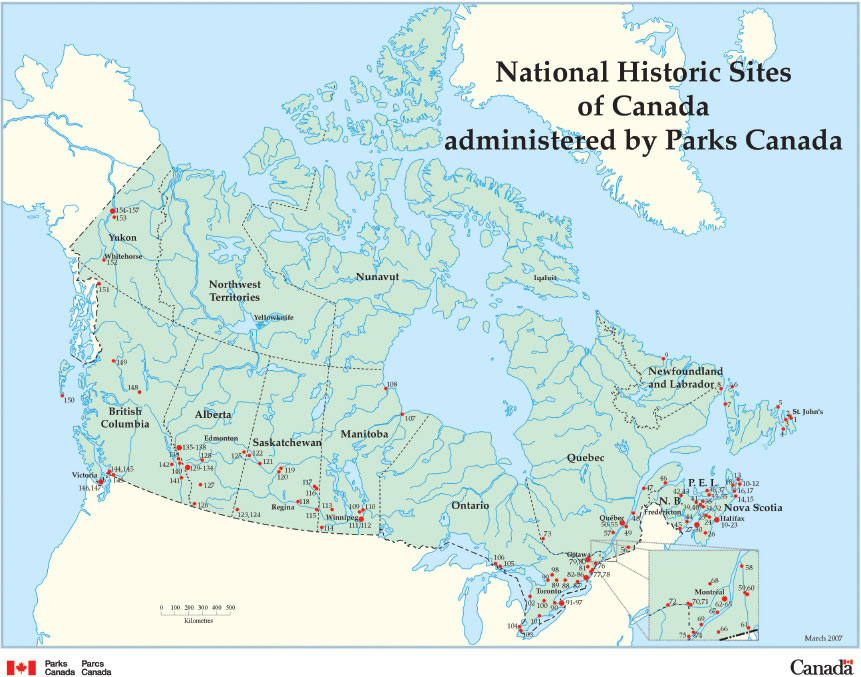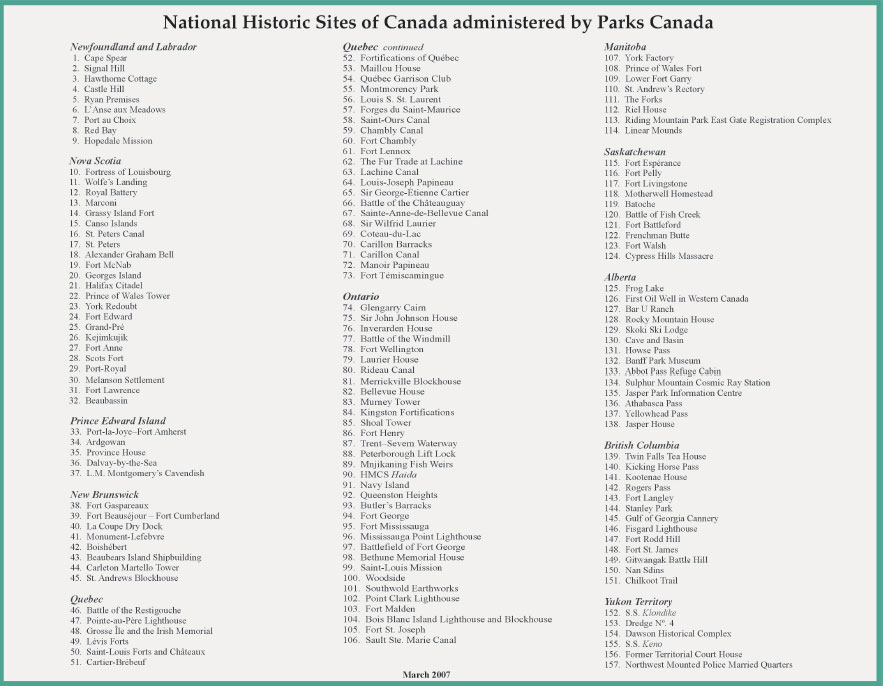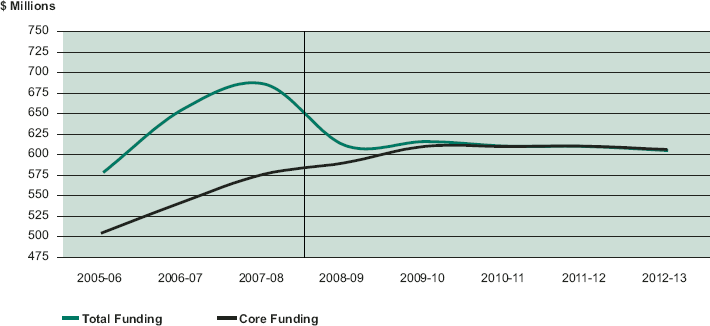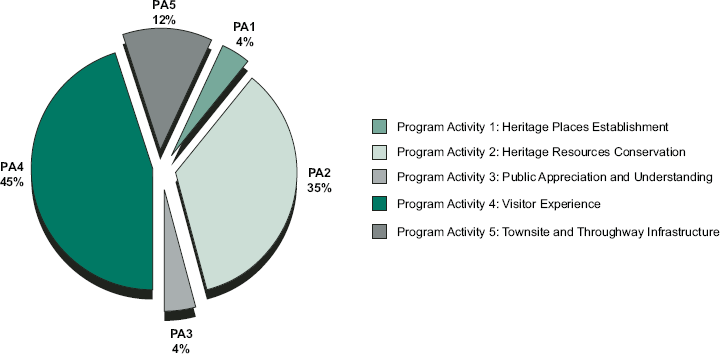Common menu bar links
Breadcrumb Trail
ARCHIVED - Parks Canada
 This page has been archived.
This page has been archived.
Archived Content
Information identified as archived on the Web is for reference, research or recordkeeping purposes. It has not been altered or updated after the date of archiving. Web pages that are archived on the Web are not subject to the Government of Canada Web Standards. As per the Communications Policy of the Government of Canada, you can request alternate formats on the "Contact Us" page.
Minister’s Message
 |
| John Baird, P.C., M.P. Minister of the Environment and Minister Responsible for Parks Canada |
Our country is filled with natural treasures from coast to coast to coast. As Canada’s Environment Minister and Minister Responsible for Parks Canada, I am constantly reminded on a daily basis of the special responsibility I share with the hundreds of hard-working Parks Canada employees who help ensure our natural treasures are protected.
Last year, Canadians celebrated the 200th anniversary of David Thompson’s first crossing of the majestic Rocky Mountains, the 175th anniversary of the Rideau Canal, the 150th anniversary of Ottawa’s designation as the capital of Canada and Jasper National Park’s 100th anniversary.
This year we celebrate together the 400th anniversary of the establishment of Quebec City, an important event in our shared history.
These events highlight that Canada has a long and proud history of exploration and development, where many have come from around the world to build this great country of ours. These events also highlight that Canada has the oldest parks service in the world.
From coast to coast to coast, in the historic district of Old-Québec, in Atlantic Canada, in the northernmost regions, in the Canadian Rockies as well as in the Prairies, Parks Canada is directly responsible for 42 national parks, three national marine conservation areas and 157 national historic sites, and encourages and supports the owners of more than 900 historic sites. It oversees a total portfolio of assets worth more than $10 billion, and hosts to over 21 million visits a year.
With this Canada-wide family of special places, Parks Canada offers Canadians a myriad of opportunities to discover, enjoy and learn about Canada’s natural wonders and about the places, persons and events that left their mark on our country’s landscape, architecture, culture, economy, population and lifestyle.
I can assure Canadians that Parks Canada offers all of these exceptional experiences in a way that ensures the ecological integrity of the national parks and the commemorative integrity of our national historic sites. We must take care of our priceless natural and cultural assets, and this Corporate Plan spells out how the Government of Canada will do so.
In the recent months, I was proud to announce on behalf of Canada’s government key investments geared at preserving more of our country’s special places, including the establishment of Lake Superior National Marine Conservation Area, the land withdrawal near East Arm Great Slave Lake, the expansion of Nahanni National Park, and a landmark agreement to work towards permanently protecting and cooperatively managing Sahoyúé - §ehdacho National Historic Site of Canada.
These initiatives demonstrate our Government’s commitment to conservation. I know that Parks Canada’s team of hard-working, dedicated and highly skilled professionals will further protect and enhance a large, complex and extremely valuable nation-wide system of national treasures, on behalf of all Canadians.
In 2008, rapidly changing demographics, world climate, tourism trends and environmental issues challenge Parks Canada to develop and implement strategies to ensure sustainable tourism, take action to ensure the commemorative and ecological integrity of sites and reach out and be relevant to a more diverse audience.
In order to meet these challenges, Parks Canada works hand in hand with Aboriginal, government, community and business partners. Together, we honour and safeguard the natural and cultural features that have defined our country’s destiny and forged our Canadian identity and we ensure their preservation for the benefit of future generations.
For more than a century, Canadians have been protecting their heritage. Our government is proud to generate and foster an even stronger culture of conservation and heritage preservation. In that spirit, the Parks Canada Agency continues working towards making the oldest park service in the world the best park service in the world.
John Baird, P.C., M.P.
Minister of the Environment and Minister Responsible for Parks Canada
Management Representation Statement
I submit for tabling in Parliament, the 2008-2009 Report on Plans and Priorities for the Parks Canada Agency.
This document has been prepared based on the reporting principles contained in the Guide for the Preparation of Part III of the 2008-2009 Estimates: Reports on Plans and Priorities and Departmental Performance Reports:
- It adheres to the specific reporting requirements of the Treasury Board Secretariat;
- It is based on the Agency’s Strategic Outcome and Program Activity Architecture that were approved by Treasury Board;
- It presents consistent, comprehensive, balanced and accurate information;
- It provides a basis of accountability for the results achieved with the resources and authorities entrusted to Parks Canada; and
- It reports finances based on approved planned spending numbers from the Treasury Board Secretariat.
Alan Latourelle
Chief Executive Officer
Parks Canada
Message from the Chief Executive Officer

The Government of Canada, through Parks Canada, is leading the way in our communities in the protection of natural and cultural heritage places and the facilitation of memorable experiences and learning opportunities. The Agency’s work is also recognized nationally and internationally, as demonstrated recently by a series of prestigious awards highlighting excellence in the ranks of the Parks Canada Agency.
In November 2007, the Parks Canada Agency received the Tourism Industry Association of Canada’s (TIAC) Business of the Year Award, an award given to the business whose significant contribution to the tourism industry is reflected in the energy, commitment to service, and vision that is evident in its operations. The Canadian Tourism Commission also honoured the Agency when it unveiled the winners of the 2006 Awards of Excellence from Interpretation Canada, where Parks Canada interpreters made a clean sweep in the Personal Interpretation category, winning gold, silver and bronze. The Agency also accepted the 2007 World Travel Market Global Award in the North American region, which was awarded to Jasper National Park of Canada in December of last year.
The Parks Canada team is hard at work in all regions of the country creating favourable conditions in which Canadians and international visitors can fully enjoy Canada’s protected heritage places and create lasting personal memories. The Parks Canada team offers excellent services for which it earns a visitor satisfaction rate of almost 90%, year after year. The satisfaction of our visitors is a testament to the excellent work of the enterprising team of Parks Canada employees. Through the years, Parks Canada has established high quality service standards, remarkable education tools, programs and conservation expertise, and the Agency is set to maintain this tradition of service to Canadians.
The character of our national parks, national historic sites and national marine conservation areas is unique. These are places where our heritage speaks to us with a grandeur, eloquence and authenticity that can’t help but move us. Every year, the Parks Canada family of special places receives more than 21 million visits. To the visitors, the parks, historic sites and marine conservation areas become classrooms where they learn about the natural and cultural heritage of Canada.
But not all Canadians are able to come and visit the sites; therefore we are developing various approaches to reach out to aging Canadians, urban communities, and new Canadians through, for example, discovery centres and new technologies. Social science information supports these new ways of providing services to Canadians, including all our interactions with audiences, clients, partners and stakeholders.
It is in this spirit that the team of committed employees at Parks Canada works hand in hand with government, Aboriginal, community and other partners to expand the network of national parks, historic sites and marine conservation areas and implement strategies for sustainable tourism, principles for ensuring the commemorative and ecological integrity of sites, and awareness programs. I am proud to present this plan, which outlines how we intend to do so.
The work before Parks Canada and our partners is significant and of great importance to Canada and the world. As Canadians, we have an opportunity to protect representative areas of our great country. However, we need to act in the next decade, as this opportunity may be lost forever. We owe it to our great-grandchildren to demonstrate leadership and to protect the natural and cultural heritage of our country so that it is also available for them to discover and experience.
As we approach our 2011 centennial celebration of being the first organization in the world specifically charged with responsibilities to manage, protect and present national parks, Parks Canada continues to work towards enhancing the connections between Canadians, their land and their stories.
Alan Latourelle
Chief Executive Officer
Parks Canada
Section I: Parks Canada Agency Overview
Raison D’être and Responsibilities
The mandate of the Parks Canada Agency is presented in the Parks Canada Agency Act:
| On behalf of the people of Canada, we protect and present nationally significant examples of Canada’s natural and cultural heritage, and foster public understanding, appreciation and enjoyment in ways that ensure the ecological and commemorative integrity of these places for present and future generations. |
Parks Canada, which was established as a separate Government of Canada Agency in 1998, derives its mandate from several pieces of legislation:
- the Parks Canada Agency Act;
- the Canada National Parks Act;
- the Canada National Marine Conservation Areas Act;
- the Historic Sites and Monuments Act; and
- the Species at Risk Act.
Parks Canada’s Chief Executive Officer reports directly to the Minister of the Environment.
Key Responsibilities
Parks Canada manages national parks, national marine conservation areas and national historic sites on behalf of Canadians. Parks Canada is a proud steward of these heritage places and protects and presents them for the benefit and enjoyment of Canadians while ensuring that they remain unimpaired for present and future generations.
National parks and national marine conservation areas are representative examples of Canada’s terrestrial and marine regions. They offer to Canadians a variety of recreational activities and learning experiences as well as a unique opportunity to personally connect with their land. Each national historic site tells its own story and contributes to our understanding of Canada as a whole. They are special places where visitors can learn about the men and women who contributed to shaping Canada as we know it today and where they can experience Canada’s history.
There are more than 21 million visits annually to the heritage places administered by Parks Canada. The Agency supports 38,000 direct jobs for Canadians, in more than 460 communities.
Other Responsibilities
In addition to managing over 150 national historic sites, Parks Canada provides support for the protection of the commemorative integrity of national historic sites owned and managed by third parties.
Parks Canada directs or coordinates activities that conserve other specific aspects of Canada’s heritage places:
- Federal Heritage Buildings;
- Heritage Railway Stations;
- Canadian Heritage Rivers System;
- Federal Archeology; and
- Grave Sites of Canadian Prime Ministers.
Parks Canada also has the legislative mandate to design and implement programs that relate primarily to built heritage. As such, it has the lead role for developing policy and implementing the Historic Places Initiative; a significant collaborative effort developed in conjunction with provinces and territories related to the nation’s built heritage and its conservation.
Parks Canada also contributes to international heritage conservation through its leadership and participation in international conventions, programs, agencies and agreements. Notably, Parks Canada represents the Government of Canada on the World Heritage Committee and is responsible for the hosting of the World Heritage Committee meeting in Quebec City in 2008.
| Parks Canada’s long-term goal is to establish at least one national park and one national marine conservation area in each of Canada’s terrestrial and marine regions. The system of national parks, presented in Figure 1, represents Canada’s terrestrial regions. As of March 31, 2007, there are 42 national parks
representing 28 of Canada’s 39 terrestrial regions making the system over 70% complete. The system of national marine conservation areas, as shown in Figure 2, represents Canada’s marine regions spanning its three oceans and the Great Lakes. This system is in the early development stages. Including the recently established Lake Superior National Marine Conservation Area, three of Canada’s 29 marine regions are represented making the system 10% complete. The system of national historic sites represents places, persons and events of national historic significance. As of March 31, 2007, Canada’s system of national historic sites includes 925 places of national historic significance. Of these, 157 are administered directly by Parks Canada as displayed in Figure 3. The system also includes 597 national historic persons and 375 national historic events. |
Figure 1: The System of National Parks of Canada
Figure 2: The System of National Marine Conservation Areas of Canada
Figure 3: National Historic Sites of Canada administered by Parks Canada
Linkages Between Strategic Outcome, Program Activities and Government of Canada Outcomes
| Strategic Outcome: Canadians have a strong sense of connection, through meaningful experiences, to their national parks, national historic sites and national marine conservation areas and these protected places are enjoyed in ways that leave them unimpaired for present and future generations. |
||
| Expected Result: | Performance Indicator: | Target and Date: |
| Same as strategic outcome | The overall state of ecological integrity in national parks | Maintain or improve the overall ecological integrity in all national parks from March 2008 to March 2013 |
| The overall state of commemorative integrity of national historic sites administered by Parks Canada | Improve the overall average commemorative integrity rating from 6.0/10 in March 2008 to 6.6/10 in March 2013 | |
| Sustainable use of national marine conservation areas | To be determined* | |
| Canadians report a personal connection to Parks Canada administered places | Establish a baseline by March 2009 for the percentage of Canadians that report a personal connection to Parks Canada administered places | |
Parks Canada Agency Funding Profile
For the 2008-09 fiscal year, Parks Canada plans to spend $610.5 million to meet the expected results of its program activities and contribute to its strategic outcome.
In 2007, Parks Canada conducted an in-depth review of the funding, relevance and performance of all its programs and spending to ensure results and value for money from programs that are a priority for Canadians. The results of this Strategic Review were submitted to Treasury Board last fall, for subsequent review by Cabinet. The results of this Review will be reflected in future reporting to Parliament.
Figure 4 illustrates Parks Canada’s funding level trend from 2005-06 to 2012-13. Two trends are represented: the core funding and the total funding.
Figure 4: Parks Canada Agency Funding Level Trend 2005-06 to 2012-13
For the 2005-06 to 2007-08 period, the total funding includes all Parliamentary appropriation and revenue sources: Main Estimates, Supplementary Estimates, Treasury Board Vote 10, 15, and 23 and revenues from user fees and rights and privileges. It also includes carry forward adjustments. For the 2008-09 to 2012-13 period, the total funding corresponds to the planned spending and revenues. Supplementary funding and carry forward adjustments are unknown at this point and are therefore not reflected.
The core funding excludes carry forward adjustments and supplementary funding for specific projects and pilot programs. It illustrates the baseline funding Parks Canada receives from Parliamentary appropriation and revenue sources.
Since 2005-06, Parks Canada’s core funding level increased due to new funding received for the improvement of ecological integrity in national parks; the protection of species at risk; the Historic Places Initiative; and recapitalization.
From 2005-06 to 2007-08, the major increases to Parks Canada’s total funding are due to one-time amounts received for two projects: Québec City 400th anniversary celebrations and the twinning of the Trans-Canada Highway through Banff National Park of Canada.
Figure 5 displays the allocation of Parks Canada funding by program activity. Parks Canada funding is primarily allocated to Program Activity 2 and 4 as they relate to the operations of the heritage places administered by Parks Canada, i.e. the conservation of the natural and cultural resources and visitor experience in national parks, national marine conservation areas and national historic sites.
Figure 5: 2008-09 Allocation of Funding by Program Activity
It should be noted that Parks Canada spends $60-$70 million per year on through highways—Program Activity 5—which represents approximately 10% of the Agency’s overall budget. Maintaining through highways open to through traffic is a Government of Canada obligation but not an element of the mandate of the Agency.
Parks Canada Agency Priorities
| Program Priorities | Type | Description |
| Establish national parks and national marine conservation areas and designate places, persons and events of national historic significance | Ongoing | In order to achieve the long-term goal of having at least one national park and one national marine conservation area for each of Canada’s 39 natural regions and 29 marine regions, Parks Canada will continue to work towards establishing new national parks and national marine conservation areas. Parks Canada will continue to support the Historic Sites and Monuments Board of Canada and the Minister in the designation and commemoration of places, persons and events of national historic significance, notably in under-represented themes. |
| Conserve existing national parks, national marine conservation areas and national historic sites administered by Parks Canada | Ongoing | Parks Canada will invest in restoration projects aimed at improving the ecological integrity of national parks. Parks Canada will improve the commemorative integrity of national historic sites it administers, notably by investing in its built cultural resources. It will do so using new social science research information to better support visitor experience. |
| Foster Canadian appreciation and understanding for the heritage places administered by Parks Canada and the engagement of stakeholders and partners | Ongoing | Through its outreach, education and communication activities, Parks Canada will build awareness of its mandate and understanding of the importance of the heritage places it administers. Parks Canada will continue its efforts to engage partners and stakeholders in the protection and presentation of the heritage places it administers. |
| Provide Canadians with meaningful experiences and quality visitor services to improve their personal connection to the heritage places administered by Parks Canada | Ongoing | Parks Canada will develop visitor experience products and services using new social science research information to ensure visitors expectations and needs are being met. It will continue to deliver quality visitor services, which will be based on new national standards and guidelines. |
| Management Priorities | Type | Description |
| Asset Investments | Ongoing | In 2006-07 dollars, the replacement value of Parks Canada’s assets is estimated at $10 billion. Investing in Parks Canada’s historic and contemporary facilities is an important priority of the Agency. In addition, $25 million in new revenues from fee increases are being reinvested to maintain and upgrade priority facilities to support visitor use and enjoyment. |
| Internal Management | Ongoing | The Agency will continue streamlining and integrating its planning and reporting instruments, including management planning, business planning and corporate planning and reporting. Planning and reporting will be aligned with the new Program Activity Architecture, with increased emphasis on performance measurement and data collection. The 2007 Management Accountability Framework (MAF) assessment identified the need for a formal risk management framework for the Agency. Key elements of the framework will be developed by the Agency in 2008-09. Another recommendation from the MAF assessment is to put in place an implementation plan for the new Internal Audit Policy that includes establishment of an audit committee with external membership. |
| Human Resources Renewal | New | Parks Canada will focus its efforts in increasing the capacity of its organization to learn and adapt to change, notably to changing demographics. This includes increased efforts to ensure that the workforce reflects the diversity of the Canadian population. |
| Environmental Management | Ongoing | While fulfilling its mandate, Parks Canada will demonstrate environmental leadership and stewardship. Parks Canada targets to reduce greenhouse gas emissions from its own operations by 5.2% from 1998-99 baseline level of 56.3 kilotonnes to a level below 53.4 kilotonnes by 2010-11. |
Key Risks, Challenges and Mitigation Strategies
Parks Canada shares with other heritage organizations the challenges of changing demographics: an ageing, increasingly urban and more diverse population. This resulted in a 22% visitation decrease in national historic sites between 2002-03 and 2006-07. Parks Canada’s ability to raise awareness of the significance of the heritage places it administers and to develop public understanding of the importance of protecting and presenting them will determine the continuing relevance of its mandate in the future.
In 2003, the Auditor General of Canada reported that two thirds of built cultural resources administered by Parks Canada were in poor to fair condition. Since then, Parks Canada has received funding to improve the condition of its assets and has started investing in priority built cultural resources and in visitor facilities. The level of investment required is such that it is not possible to address all issues in the short term, therefore, issues will be addressed on a priority basis. As it makes investment decisions, Parks Canada will build its social research capacity and work more closely with its many partners to better support visitor experiences and product development and to ensure that visitor facilities are adapted to the new needs of Canadians.
In some places, native biodiversity and habitat are under considerable stress which impact the ecological integrity of national parks. In existing national parks, Parks Canada will invest resources in restoration initiatives, active management and education projects that can make a demonstrable difference.
National park and national marine conservation area establishment is a complex process in which the development of long term and trusting relationships is key. Challenges include competing land use interests in southern Canada and working in the complex northern environment where resources development and Aboriginal land claim settlements are important factors. Parks Canada will continue to work collaboratively with Aboriginal Peoples, provincial and territorial governments, stakeholders and local communities in the establishment of new or expanded national parks, and land use in areas adjoining national parks.
Aboriginal Peoples have long been supporters of Canada’s national parks and national historic sites systems. Parks Canada will continue to work closely with Aboriginal groups within the framework of land claim agreements, Court decisions and existing establishment agreements to manage heritage areas. However, building a trusting relationship must go beyond Parks Canada simply meeting the evolving legal obligation to consult. Ultimately, the interest of Aboriginal Peoples, Parks Canada and the public are best served by Aboriginal People’s meaningful involvement in all aspects of park management.
The system of national marine conservation areas is relatively new, yet public concern over the condition of Oceans and Great Lakes is high. Building public understanding and support are critical to success in expanding the system.






